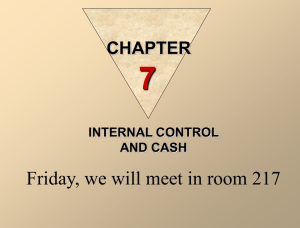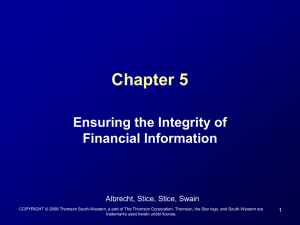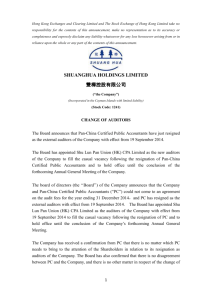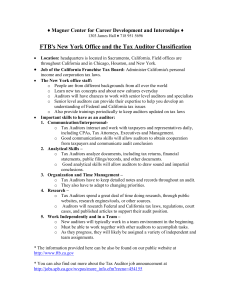Document 13134614
advertisement
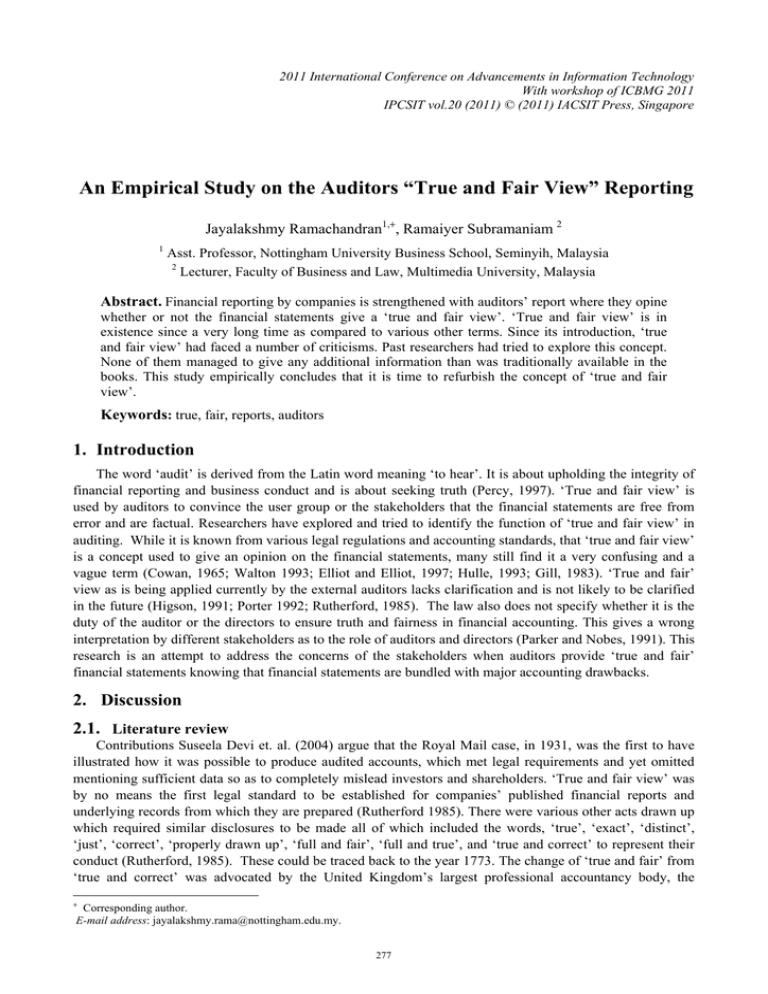
2011 International Conference on Advancements in Information Technology With workshop of ICBMG 2011 IPCSIT vol.20 (2011) © (2011) IACSIT Press, Singapore An Empirical Study on the Auditors “True and Fair View” Reporting Jayalakshmy Ramachandran1,+, Ramaiyer Subramaniam 2 1 Asst. Professor, Nottingham University Business School, Seminyih, Malaysia 2 Lecturer, Faculty of Business and Law, Multimedia University, Malaysia Abstract. Financial reporting by companies is strengthened with auditors’ report where they opine whether or not the financial statements give a ‘true and fair view’. ‘True and fair view’ is in existence since a very long time as compared to various other terms. Since its introduction, ‘true and fair view’ had faced a number of criticisms. Past researchers had tried to explore this concept. None of them managed to give any additional information than was traditionally available in the books. This study empirically concludes that it is time to refurbish the concept of ‘true and fair view’. Keywords: true, fair, reports, auditors 1. Introduction The word ‘audit’ is derived from the Latin word meaning ‘to hear’. It is about upholding the integrity of financial reporting and business conduct and is about seeking truth (Percy, 1997). ‘True and fair view’ is used by auditors to convince the user group or the stakeholders that the financial statements are free from error and are factual. Researchers have explored and tried to identify the function of ‘true and fair view’ in auditing. While it is known from various legal regulations and accounting standards, that ‘true and fair view’ is a concept used to give an opinion on the financial statements, many still find it a very confusing and a vague term (Cowan, 1965; Walton 1993; Elliot and Elliot, 1997; Hulle, 1993; Gill, 1983). ‘True and fair’ view as is being applied currently by the external auditors lacks clarification and is not likely to be clarified in the future (Higson, 1991; Porter 1992; Rutherford, 1985). The law also does not specify whether it is the duty of the auditor or the directors to ensure truth and fairness in financial accounting. This gives a wrong interpretation by different stakeholders as to the role of auditors and directors (Parker and Nobes, 1991). This research is an attempt to address the concerns of the stakeholders when auditors provide ‘true and fair’ financial statements knowing that financial statements are bundled with major accounting drawbacks. 2. Discussion 2.1. Literature review Contributions Suseela Devi et. al. (2004) argue that the Royal Mail case, in 1931, was the first to have illustrated how it was possible to produce audited accounts, which met legal requirements and yet omitted mentioning sufficient data so as to completely mislead investors and shareholders. ‘True and fair view’ was by no means the first legal standard to be established for companies’ published financial reports and underlying records from which they are prepared (Rutherford 1985). There were various other acts drawn up which required similar disclosures to be made all of which included the words, ‘true’, ‘exact’, ‘distinct’, ‘just’, ‘correct’, ‘properly drawn up’, ‘full and fair’, ‘full and true’, and ‘true and correct’ to represent their conduct (Rutherford, 1985). These could be traced back to the year 1773. The change of ‘true and fair’ from ‘true and correct’ was advocated by the United Kingdom’s largest professional accountancy body, the + Corresponding author. E-mail address: jayalakshmy.rama@nottingham.edu.my. 277 Institute of Chartered Accountants of England and Wales (Amat, Blake and Oliveras, 1996). The ‘true and fair’ attestation is generally understood to require compliance with applicable accounting standards (Kershaw, 2006). However, the case of Parmalat was used by Andrea Melis, (2005) in order to prove that the relationship between the corporate financial reporting and corporate governance influenced, negatively, the enforcement of the ‘true and fair view’ accounting principle. It was observed that ‘true and fair view’ reporting became just a chance for the auditor’s gateway. With the introduction of the Fourth Council Directive of the European Economic Community, ‘true and fair view’ was introduced as an accounting concept within the whole European Union (Ekholm and Troberg, 1998). Further developments took place when the ‘override’ principle of ‘true and fair’ view was introduced by the European Economic Community as a means of ‘accounting harmonisation’. Subsequently, though, it was found difficult to adapt ‘true and fair view’ due to language barriers. The United States accounting and United Kingdom accounting methodologies adopted similar versions of the ultimate goal of financial reporting (Cunningham, 2003). While in United States financial reports need to show a fair presentation in accordance with GAAP, in United Kingdom the financial statements need to present a ‘true and fair view’ of the business conditions and the results, claims the author. Ironically, in both these cases the law has not defined the term. Thus the achievement of fairness or ‘true and fair’ view still depends upon professional judgment and application of general rules in specific situations. It was claimed by Rathi (2009) that “It is really not possible and practical to frame an opinion of true and fair particularly when the company has single auditor with strong goodwill, and if it is done, it is bound to be infected by anomalies and imperfections as evident in the recent “Satyam” episode” 2.2 Research methodology and findings e1 e2 .36 e3 .56 e4 .42 .22 .19 .35 .18 .29 .03 .04 b40 b41 b42 b43 b44 b35 b38 b39 .59 .54 .16-.20 .60.75 .65 .43 .35 e10 e9 b21 .27 .52 e8 b22 .16 .14 .20 .44 .44.55 .40 .37.67 .02 F3 .60 .52 b8 e44 .15 F2 b9 .04 .07 b23 F5 .17 .30 .21 .39 .52 .25 e47 .32 b10 e48 b11 e19 .15 .52 .27 .58 b12 .34 .54 .17 .74 e46 .01 .55 .61 .37 e7 .30 b1 b2 b3 b4 b5 F1 b34 .27 e11 e12 e13 e14 e15 e6 e49 e50 e5 .35 .35 .21 b14 e20 e21 .30 .55 e45 F4 .42.63.56 .18 .40 .31 b37 .55 .37 F6 .54 .45 .25-.21 .30 .31 .09 .20 .23 .05 .06 .05 b24 b25 b26 b27 b30 b29 b55 b54 b53 e25 e24 e23 e51 e52 e53 e34 e33 e32 .17 Fig. 1 Structure Equation Model. 278 e40 e22 .22 The figure shows the model generated through the research framework that was analyzed for hypothesis testing. The model projects the regression values and the table below shows the p-values based on which hypotheses 1 to 5 were supported (p<0.05) and positive relationship was observed while the sixth hypothesis was rejected (p>0.05). The research framework for this study was formed with five independent variables and one dependent variable. Six hypotheses were developed. Hypothesis 1 (H1): Restrictions set by professional codes of ethics and Company Law has an influence on the ‘true and fair view’ opinion given by the auditors. Hypothesis 2 (H2): Independence of the auditors has an influence on the ‘true and fair view’ opinion given by the auditors. Hypothesis 3 (H3): Fee received from provision of non-audit services has influence on auditor’s independence. Hypothesis 4 (H4): Interpretation of the concept of ‘true and fair view’ has an influence on the satisfaction of the stakeholders. Hypothesis 5 (H5): Satisfaction of stakeholders has an influence on the ‘true and fair view’ opinion given by the auditors. Hypothesis 6 (H6): Interpretation of the concept of ‘true and fair view’ by the stakeholders has an influence on the ‘true and fair view’ opinion by the auditors. This research used Likert scale questionnaire method and 2050 usable .questionnaires were analysed using structured equation modeling after testing the same for reliability, validity and correlations. Figure 1 shows the model The following findings were relevant to this study. Firstly in order to achieve true and fair view in financial statements, the professional codes of ethics and companies’ law must be stricter. Secondly a close positive influence of independence of auditors on ‘true and fair view’ as was revealed in the studies conducted earlier. This was interpreted as the higher the level of independence higher will be the truth in ‘true and fair view’. Thirdly acceptance of non-audit services alongside audit service is of a growing concern. In order to avoid such future turmoil, this research suggests that the law makers and the professional bodies should try to curb this aspect to a certain extent, if not fully. Fourthly, a positive relationship established suggested that if the stakeholders are able to interpret the auditors’ true and fair view report, their level of satisfaction will be higher. Fifthly, there is a close positive relationship between satisfaction of the stakeholders and the concept of ‘true and fair view’. This means that higher the satisfaction of the stakeholders higher will be their demand to retain the concept. Finally, it could be concluded that the concept of ‘true and fair’ is a very old concept. Lots of minor changes were tried on this concept leading to more confusion and befuddling for the stakeholders. It is seen that lack of independence of the auditors and lack of initiatives by the professional bodies and standard setters, have caused many audit firms or audit partners to take undue advantage of the same and eventually dwindle the funds of the stakeholders. Stakeholders being non specialists in accounting find it difficult to understand and interpret accounting language which is more technical in nature. They depend on the auditors to inform them about the companies, which is what is being explained and put forth when certified as ‘true and fair’. Unfortunately the phrase ‘true and fair’ by itself is very technical and confusing leading to dissatisfaction on the part of the stakeholders. In conclusion, it can be seen from the responses that if this concept is not clarified, the misunderstandings and the expectation gap as well as the conflict of interest between the information user and the information provider is likely to increase. ‘True and fair view’ thus needs to be refurbished in the absence of which the entire 279 exercise of reporting and communication would become futile and will remain merely a legal formality. SEM Model fit summaries CMIN Model Default model Saturated model Independence model RMR, GFI Model Default model Saturated model Independence model Parsimony-Adjusted Measures Model Default model Saturated model Independence model RMSEA Model Default model Independence model CFI/TLI Model Default model Saturated model Independence model NPAR 74 465 30 CMIN 1092.797 .000 3751.676 RMR .067 .000 .119 DF 391 0 435 GFI .912 1.000 .572 P .000 CMIN/DF 2.795 .000 8.625 AGFI .903 PGFI .901 .542 .535 PRATIO .926 .000 1.000 RMSEA .054 .111 NFI Delta1 .898 1.000 .000 PNFI .553 .000 .000 LO 90 .050 .108 RFI rho1 .914 .000 HI 90 .058 .114 IFI Delta2 .932 1.000 .000 PCFI .625 .000 .000 PCLOSE .045 .000 TLI rho2 .917 .000 CFI .928 1.000 .000 Regression Weights: (Final Model) F5 b40 b41 b42 b43 b44 b35 b38 b39 F4 F6 b34 b23 b22 b21 F6 <--<--<--<--<--<--<--<--<--<--<--<--<--<--<--<--- F1 F1 F1 F1 F1 F1 F1 F1 F1 F2 F2 F2 F2 F2 F2 F3 Unstandadized Estimate .391 1.000 1.090 .885 1.009 .909 .900 .198 -.294 .637 .114 .930 1.000 .882 .869 .199 280 S.E. C.R. P .060 6.504 *** .090 .079 .087 .088 .086 .057 .072 .079 .091 .093 12.079 11.144 11.574 10.337 10.503 3.455 -4.089 8.104 1.259 9.981 *** *** *** *** *** *** *** *** .208 *** .095 .094 .081 9.245 9.247 2.454 *** *** .014 Standardized Estimate .599 .568 .707 .616 .655 .550 .563 .158 -.188 .740 .184 .595 .609 .524 .524 .177 b1 b2 b3 b4 b5 F6 b26 b25 b24 b27 b30 b29 F6 b8 b14 b37 b12 b9 b11 b10 b53 b54 b55 <--<--<--<--<--<--<--<--<--<--<--<--<--<--<--<--<--<--<--<--<--<--<--- F3 F3 F3 F3 F3 F4 F4 F4 F4 F4 F4 F4 F5 F5 F5 F5 F5 F5 F5 F5 F6 F6 F6 Unstandadized Estimate 1.000 1.713 1.696 1.316 1.022 .239 1.000 1.061 .607 .484 .416 -.359 .495 .499 1.322 1.254 1.208 .431 1.000 .636 1.000 .812 1.240 S.E. C.R. P .217 .218 .178 .149 .111 7.883 7.789 7.379 6.868 2.158 *** *** *** *** .031 .115 .083 .108 .093 .093 .096 .130 .187 .181 .176 .149 9.250 7.340 4.477 4.493 -3.868 5.152 3.836 7.080 6.917 6.859 2.900 *** *** *** *** *** *** *** *** *** *** .004 .137 4.649 *** .161 .191 5.033 6.483 *** *** Standardized Estimate .445 .628 .597 .517 .447 .332 .559 .639 .417 .229 .230 -.195 .550 .206 .559 .524 .512 .149 .401 .264 .456 .319 .530 3. Acknowledgements Mr. K. Gopalakrishnan, Account Manager, Tamil Nadu, Make my Trip India Pvt. Ltd. 4. References [1] O. Amat,., J. Blake, and E.Oliveras, (1996), Spanish auditors and the True and Fair View, Working paper, 1-21 [2] T. K..Cowan (1965), Are truth and fairness generally acceptable, The Accounting Review, Vol 40, Iss. October, 788-794. [3] I. A. Cunningham (2003), Semiotics, Hermeneutics and Cash: An Essay on the True and Fair View, Research paper, 1-28. [4] G. Dean and F. Clarke (2004), Principles VS Rules: True and Fair View and IFRSS, Abacus, Vol 40. No. 2, 1-2 [5] D. Flint (1982), A true and fair view in Company Accounts, (London: Gee and Co for the Institute of Chartered Accountants of Scotland, 1982), 1-47. [6] G. S. Gill (1983), True and Fair View, The Australian Accountant, November issue, 701-703 [7] A. Higson (1992), Communication through the audit report: What is the auditor trying to say?, Research paper, 127. [8] K. A. Houghton, and C. A. Jubb, (2003), The market for financial report audits: Regulation of and competition or auditor independence, Law and Policy, Vol 25, No 3, 300-32. [9] R. Karan, (2003), Irreconcilable legal and accounting views of ‘A true and fair view’: An emerging alternative from Australian reforms, Research paper, 1-26 [10] G Livne and M. McNichols (2003), An Empirical investigation of the True and Fair Override, Research paper, Stamford University, 1-48 281 [11] C. K.. Low and H.C. Koh (1997), Concepts Associated with the ‘True and Fair View’: Evidence from Singapore, Accounting and Business Research, Vol 27, No 3, 195-202 [12] A. Melis, (2005), Critical Issues on the enforcement of the “True and Fair View” accounting principle. Learning from Parmalat, Corporte Ownership and Control, Vol 2, Issue 2, Winter, 108-118 [13] D. Ordelheide, (1993), True and Fair View A European and a German perspective, The European Accounting Review, Vol 5, No 3, 495-506 [14] R. H.Parker, and C. W. Nobes.(1991), True and Fair: UK Auditors’ View, Accounting and Business Research, Vol 21 No 84, 349-361 [15] J.P.Percy (1997), Auditing and Corporate Governance – A Look Forward into the 21st Century, International Journal of Auditing, Vol. 1, No. 1, 3-12 [16] B. Porter (1992), True and Fair View – An Elusive Concept, Akauntan Nasional, July issue, 16-18 [17] H. R. Rathi. (2009), “ True and Fair Auditing – an insight”, The Audit Comments [18] B. A. Rutherford (1985), ‘The True and Fair View Doctrine: A search for Explication’, Journal of Business Finance & Accounting, Vol 12, issue 4, pp483-494 [19] P. Walton, (1993), Introduction: the true and fair view in British accounting, The European Accounting Review, Vol 1, 49-58 [20] P. Sucher, W. Seal, and I. Zelenka, (1996), True and Fair in the Czech Republic: a note on local perceptions, The European Accounting Review, Vol 5, No 3, 545-557 282
